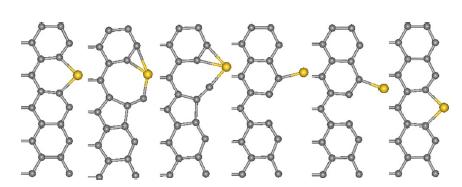 Navigation Navigation |
|
| Simulation of nano-structure materials
|
|
Gold-embedded zigzag graphene nanoribbons as spin gapless semiconductors |
| Using density-functional theory calculations, we studied the electronic and magnetic properties of zigzag
graphene nanoribbons (ZGNRs) with gold (Au) atoms embedded into different sites of the ZGNRs. Strong site
dependence was found, and the system had the ferromagnetic or antiferromagnetic ground state depending on the
Au atom position. Spin gapless semiconductor (SGS) behavior was observed when the Au atom was embedded
into the center and edge sites of the ZGNRs. The simulations showed that the electronic structure of the ribbon
strongly depends on ZGNR width, but the SGS behavior is always present when the Au atom is embedded into
the center and edge sites. The SGS properties were also found to be dependent on impurity atom concentration,
so that they can be tuned by either selecting the proper positions of Au atoms or changing their concentration.
Our results suggest a flexible way of designing SGSs, which could be used in various spintronic, electronic, and
optoelectronic applications. |
 |
| (a) Atomic structure of a ZGNR. Symbols
A to G denote different substitutional sites. (b) Structural model of
Au-A-ZGNR. The white, gray, and yellowballs are hydrogen, carbon,
and gold atoms, respectively. |
|
| Band structures of (a) FM Au-A-ZGNR, (b) FM Au-B-ZGNR, (c) FM Au-C-ZGNR, and (d) AFM Au-D-ZGNR. |
| Publications: X. H. Hu, W. Zhang, L. T. Sun*, A. V. Krasheninnikov, “Gold-embedded zigzag graphene nanoribbons as spin gapless semiconductors”, Physical Review B 86, 195418-1-7 (2012) |
| Materials Studio is one of the most famous softwares to do the simulation in material field. It is the simulation that can mostly guide the real experiment. Via Forcite/Dmol3/ CASTEP, we have discussed properties of various of nanostructures. |
Migration of gold atoms in graphene ribbons: Role of the edges |
The migration of gold atoms attached to single vacancies near the edges of graphene ribbons is studied using
density-functional theory calculations. The stable position for a single gold atom is found to be on top of a
vacancy, as in an infinite graphene sheet. An energy of 5 eV is needed for the Au atom to move through the
vacancy to the other side of the sheet, but the Au atom can migrate in lateral direction together with the
vacancy, with a migration barrier of about 2.2 eV. The sites near the edges of the graphene layer are energetically
more favorable for gold-atom-vacancy pairs than sites in the middle of extended graphene layers. The
migration barriers for different pathways show that it is easier for the gold atom to move toward the edge
where it can be captured. When the gold atom reaches the edge, it can migrate along the edge with an energy
barrier of only 1.4 eV. Our results explain recent experimental observations [Y. Gan et al., Small 4, 587
(2008)] and provide information on the dynamics of metal atoms on substitutional sites in graphene as well as
on their agglomeration at defects and at edges of graphene ribbons. |
 |
FIG. 5. (Color online) The migration path for the Au atom at the
edge site, as found by the NEB method. |
Publications:
Wei Zhang, Litao Sun*, Zijian Xu, Arkady V. Krasheninnikov, Ping Huai, Zhiyuan Zhu, F. Banhart “Migration of gold atoms in graphene ribbons: role of the edges", Phys. Rev. B 81, 125425-1-5 (2010) |
| 1 2 3 4 5 |
|

